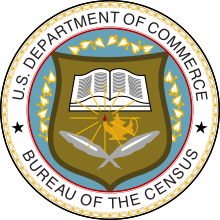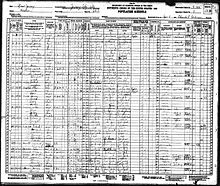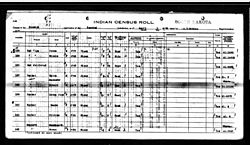
The 2000 United States census, conducted by the Census Bureau, determined the resident population of the United States on April 1, 2000, to be 281,421,906, an increase of 13.2 percent over the 248,709,873 people enumerated during the 1990 census. This was the twenty-second federal census and was at the time the largest civilly administered peacetime effort in the United States.

The United States census is a census that is legally mandated by the Constitution of the United States. It takes place every ten years. The first census after the American Revolution was taken in 1790 under Secretary of State Thomas Jefferson. There have been 23 federal censuses since that time. The census includes territories of the United States. The United States Census Bureau is responsible for conducting the census.

The 1990 United States census, conducted by the Census Bureau, determined the resident population of the United States to be 248,709,873, an increase of 9.8 percent over the 226,545,805 persons enumerated during the 1980 census.

The 1890 United States census was taken beginning June 2, 1890. The census determined the resident population of the United States to be 62,979,766, an increase of 25.5 percent over the 50,189,209 persons enumerated during the 1880 census. The data reported that the distribution of the population had resulted in the disappearance of the American frontier.

The 1850 United States census was the seventh decennial United States Census Conducted by the Census Office, it determined the resident population of the United States to be 23,191,876—an increase of 35.9 percent over the 17,069,453 persons enumerated during the 1840 census. The total population included 3,204,313 enslaved people.

The 1840 United States census was the sixth census of the United States. Conducted by U.S. marshals on June 1, 1840, it determined the resident population of the United States to be 17,069,453 – an increase of 32.7 percent over the 12,866,020 persons enumerated during the 1830 census. The total population included 2,487,355 slaves. In 1840, the center of population was about 260 miles (418 km) west of Washington, D.C., near Weston, Virginia.

The 1980 United States census, conducted by the Census Bureau, determined the resident population of the United States to be 226,545,805, an increase of 11.4% over the 203,184,772 persons enumerated during the 1970 census. It was the first census in which a state—California—recorded a population of 20 million people, as well as the first in which all states recorded populations of over 400,000.
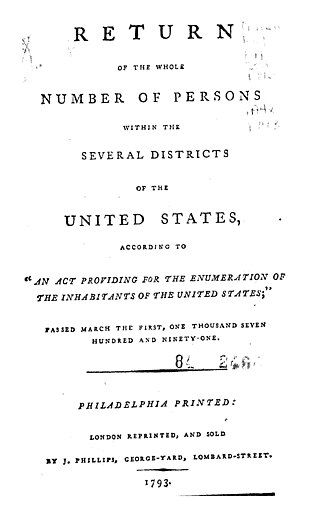
The 1790 United States census was the first United States census. It recorded the population of the whole United States as of Census Day, August 2, 1790, as mandated by Article 1, Section 2, of the Constitution and applicable laws. In the first census, the population of the United States was enumerated to be 3,929,214 inhabitants.

The 1800 United States census was the second census conducted in the United States. It was conducted on August 4, 1800. It showed that 5,308,483 people were living in the United States, of whom 893,602 were slaves. The 1800 census included the new District of Columbia. The census for the following states were lost: Georgia, Kentucky, New Jersey, Tennessee, and Virginia.

The 1810 United States census was the third census conducted in the United States. It was conducted on August 6, 1810. It showed that 7,239,881 people were living in the United States, of whom 1,191,362 were slaves.
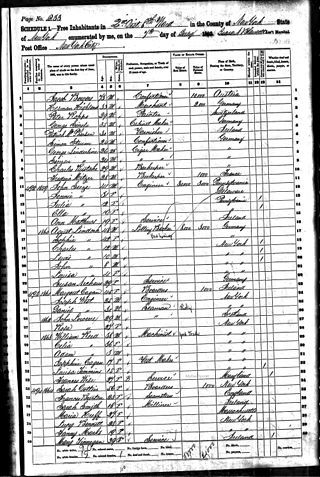
The 1860 United States census was the eighth census conducted in the United States starting June 1, 1860, and lasting five months. It determined the population of the United States to be 31,443,321 in 33 states and 10 organized territories. This was an increase of 35.6 percent over the 23,191,876 persons enumerated during the 1850 census. The total population included 3,953,760 slaves.

The 1880 United States census, conducted by the Census Office during June 1880, was the tenth United States census. It was the first time that women were permitted to be enumerators. The Superintendent of the Census was Francis Amasa Walker. This was the first census in which a city—New York City—recorded a population of over one million, and the first census in which the 20 most populated cities all recorded over 100,000 residents.

The 1870 United States census was the ninth United States census. It was conducted by the Census Office from June 1, 1870, to August 23, 1871. The 1870 census was the first census to provide detailed information on the African American population, only five years after the culmination of the Civil War when slaves were granted freedom. The total population was 38,925,598 with a resident population of 38,558,371 individuals, a 22.6% increase from 1860.

The 1900 United States census, conducted by the Census Office on June 1, 1900, determined the resident population of the United States to be 76,212,168, an increase of 21.01% from the 62,979,766 persons enumerated during the 1890 census. It was the last census to be conducted before the founding of the permanent United States Census Bureau.

The 1910 United States census, conducted by the Census Bureau on April 15, 1910, determined the resident population of the United States to be 92,228,496, an increase of 21 percent over the 76,212,168 persons enumerated during the 1900 census. The 1910 census switched from a portrait page orientation to a landscape orientation.

The 1920 United States census, conducted by the Census Bureau during one month from January 5, 1920, determined the resident population of the United States to be 106,021,537, an increase of 15.0 percent over the 92,228,496 persons enumerated during the 1910 census.

The 1940 United States census, conducted by the Census Bureau, determined the resident population of the United States to be 132,164,569, an increase of 7.6 percent over the 1930 population of 122,775,046 people. The census date of record was April 1, 1940.

The 1950 United States census, conducted by the Census Bureau, determined the resident population of the United States to be 151,325,798, an increase of 14.5 percent over the 131,669,275 persons enumerated during the 1940 census.

The 1960 United States census, conducted by the Census Bureau, determined the resident population of the United States to be 179,323,175, an increase of 19 percent over the 151,325,798 persons enumerated during the 1950 census. This was the first census in which all states recorded a population of over 200,000. This census's data determined the electoral votes for the 1964 and 1968 presidential elections. This was also the last census in which New York was the most populous state.

The 1970 United States census, conducted by the Census Bureau, determined the resident population of the United States to be 203,392,031, an increase of 13.4 percent over the 179,323,175 persons enumerated during the 1960 census.
